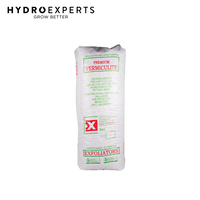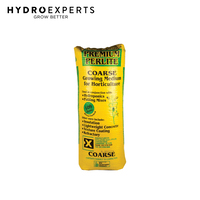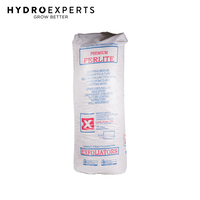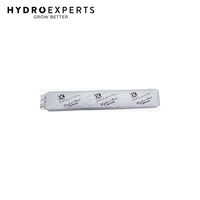Hydroponics grow medium perlites are derived from volcanic glass created when lava encounters water. When the glasses are superheated, the water vaporises and causes small granules to puff out like popcorn, creating a porous surface. Perlites are white, hard, lightweight, highly porous and pH neutral with air-holding capacity which keeps root zones of plant aerated. Vermiculites are similar to perlites derived from superheating the silicates but are soft, tan/brown in colour. Perlites hold more air and less water than vermiculites so need to be irrigated more frequently. Both can be used by itself or used in potting soils. However, both floats so they are not the best choice for growing media for the flood and drain system.
We, at Hydro Experts, sell a wide range of perlite and vermiculite such as Exfoliators premium vermiculite, Auspert expanded perlite, Exfoliators premium perlite, and more.
1 Related Content Found
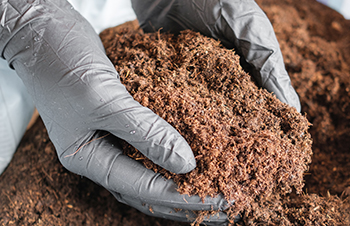
How to Use Soil Amendments-Sphagnum Peat Moss
Perlites: Lightweight Guardians of Root Health
Discover the power of perlites, nature's lightweight gift to horticulture. These granules, akin to popcorn in texture, emerge from the union of lava and water vaporization. They present a porous surface that aerates the root zone, ensuring optimal oxygen supply. White, hardy, and pH-neutral, perlites are steadfast defenders of root health. Their exceptional air-holding capacity prevents waterlogging, keeping your plants aerated and thriving.
Why Perlites?
- Lightweight and easy to handle for effortless gardening.
- pH-neutral composition ensures a balanced environment for plant roots.
- Promotes aeration, vital for root respiration and nutrient uptake.
- Exceptional drainage properties, preventing overwatering and root rot.
- Versatile for use in potting soils or as a standalone medium.
Vermiculites: Nurturing Growth with Gentle Precision
Embrace the nurturing touch of vermiculites, born from superheated silicates. These soft, tan-brown flakes cradle your plants in a cocoon of support. With a natural affinity for water, vermiculites maintain a delicate balance of moisture and aeration. They offer a gentle embrace, fostering robust root systems and vibrant growth.
Why Vermiculites?
- Hydrates and nurtures plants with a gentle touch, perfect for sensitive species.
- Encourages rapid rooting, making it ideal for seedlings and cuttings.
- Provides consistent moisture levels, reducing watering frequency.
- Enhances soil quality by retaining nutrients for sustained plant growth.
Perlite and Vermiculite: A Dynamic Duo
Can't choose between perlites and vermiculites? You don't have to! Harness the combined power of these grow mediums to create the ultimate foundation for your plants. Their synergistic dance ensures the perfect balance of aeration, moisture, and drainage.
Are perlite and vermiculite the same?
No, perlite and vermiculite are distinct materials with unique properties. Perlite excels in aeration and drainage, while vermiculite specializes in moisture retention and nurturing root growth.
Should I use vermiculite and perlite together?
Absolutely! Combining vermiculite and perlite in your potting mix creates an optimal environment for your plants. Perlite aids in aeration and drainage, while vermiculite ensures consistent moisture levels, resulting in healthy, thriving plants.
How to Use Perlite and Vermiculite Together?
Integrate both mediums into your potting mix for a powerhouse combination. Perlite, with its exceptional drainage properties, complements vermiculite's moisture-retaining capabilities. Achieve a harmonious blend for thriving plants.
Q: How to use perlite?
A:
Enhance Drainage with Perlite: When potting succulents or other plants that are sensitive to excessive moisture, incorporate perlite into the potting soil. Perlite helps maintain proper aeration in the soil and facilitates effective water drainage, ensuring that the plant's roots do not become waterlogged. Combine perlite with compost at a ratio of approximately 1:4. Mix these components together before planting to ensure an even distribution.
Improve Rooting with Perlite in Cuttings: Perlite can enhance water retention in compost, increasing the likelihood of successful root development when propagating plants from cuttings. To achieve this, use a specialized cutting compost with a finer texture and lower nutrient content than general-purpose compost. Blend perlite with this cutting compost at a 1:1 ratio. Fill the pots with the mixture, thoroughly water it, and allow it to drain for several hours before inserting your cuttings. Alternatively, you can root cuttings directly in perlite. Moisturize the perlite, fill a polythene bag to about one-third full, prepare your cuttings, insert them into the perlite, seal the bag, and wait for roots to develop over several weeks. Once well-established, transfer the rooted cuttings to compost.
Seed Sowing with Perlite: For delicate seedlings, mix perlite into your seed and cuttings compost at a 1:1 ratio. This creates an ideal environment for delicate seedling roots by maintaining moisture levels. Additionally, a thin layer of perlite works excellently for covering seeds that require light for germination. Perlite allows light to penetrate while ensuring the seeds remain moist, facilitating the germination process.
Q: How to use vermiculite?
A: Vermiculite serves as an excellent soil conditioner, providing aeration while retaining moisture and nutrients, gradually releasing them over time. This makes vermiculite a valuable resource for seed sowing and propagation. It can also be incorporated into house plant compost. You may encounter different grades of vermiculite flakes, with the finest being suitable for seed sowing and larger sizes ideal for potting on, taking cuttings, and tending to house plants.
Seed Sowing: You can sow seeds of all sizes directly into 100% vermiculite. Alternatively, create a mixture by combining vermiculite and seed-sowing compost in a 50:50 ratio. Another approach is to use only sowing compost and then cover the seed tray with a layer of vermiculite after sowing. This vermiculite cover serves multiple purposes: it helps maintain moisture in the compost, acts as a defence against damping-off fungus, and provides insulation against temperature and humidity changes in the greenhouse.
Pricking Out and Cuttings: For pricking out seedlings and potting them on, a blend containing around 30% vermiculite is ideal. This mixture also proves beneficial for propagating plant cuttings.
House Plants: Vermiculite's water-retaining and moisture-draining properties make it an excellent addition to the compost of house plants that tend to require frequent watering, such as the maidenhair fern (Adiantum raddianum) and peace lily. Plant roots can access moisture as needed because vermiculite releases it gradually. Since vermiculite retains moisture for an extended period, you'll find that you need to water your house plants less frequently. Additionally, vermiculite promotes aeration in the compost, preventing it from becoming compacted or developing a crust. An ideal mix for house plants consists of a 50:50 blend of house plant compost and vermiculite.





